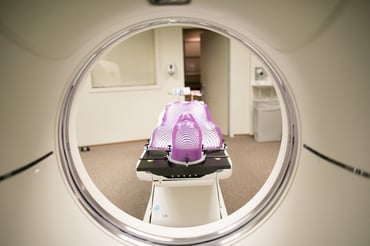
Throat cancer is often thought of as a single type of cancer, but it actually refers to a group of cancers that can develop in different parts of the throat. Each type's point of origin is in a different area of the throat, which is how they get their names. What are the various types of throat cancers, and how do their symptoms and treatments vary?
Anatomy of the Throat
The throat consists of two main parts: the pharynx and the larynx. Throat cancer can develop in either area.
The pharynx is a hollow, muscular tube located in the neck. It begins behind the nose and extends down to the esophagus. Both air and food pass through the pharynx on their way to the trachea (windpipe) or esophagus, where your food passes through to your stomach.
 The pharynx is divided into three sections:
The pharynx is divided into three sections:
- The upper pharynx, located behind the nose
- The middle pharynx, which includes the soft palate (the back of the mouth), the base of the tongue, and the tonsils
- The lower pharynx
Among these sections, the middle part of the pharynx is the most common site for cancer to develop.
The larynx, also known as the voice box, is a short passageway made of cartilage located just below the pharynx in the neck. The larynx houses the vocal cords, which vibrate to produce sound when air passes through them. This sound then echoes through the pharynx, mouth, and nose, forming a person's voice. Additionally, the larynx contains a small flap of tissue called the epiglottis, which moves to cover the larynx and prevent food from entering the lungs.
Types of Throat Cancer and Their Differences
Nasopharyngeal Cancer
Nasopharyngeal cancer develops in the nasopharynx, which is located behind the nasal cavity and is the upper section of the pharynx. Most instances of nasopharyngeal cancer are classified as squamous cell carcinoma since almost all cases of nasopharyngeal cancer originate in the lining of this structure, which consists of thin, flat cells known as squamous cells.
Symptoms associated with nasopharyngeal cancer typically include:
- Swollen lymph nodes
- Nosebleeds
- Nasal congestion
- Blurred or double vision
- Frequent headaches
- Hearing problems, including hearing loss and ringing in the ears
- Difficulty breathing, speaking, and swallowing
- Trouble opening the mouth
- Recurrent ear infections
While the exact cause of nasopharyngeal cancer is not fully understood, certain risk factors may increase a person's likelihood of developing the disease. These risk factors include:
- Infection with the Epstein-Barr virus, which is linked to various cancers
- Being male
- Heavy alcohol consumption
- A family history of the disease
- Living in or having ancestry in certain parts of Asia, North Africa, and the Arctic
In the United States, where nasopharyngeal cancer is less common than in other parts of the world, it is most likely to be diagnosed in people who are 50 or older.
Oropharyngeal Cancer
Oropharyngeal cancer begins in the mucosa, or lining, of the oropharynx, which is the middle section of the pharynx. This area of the throat includes the base of the tongue, the tonsils, and the soft palate. It is the most common type of throat cancer and is usually classified as squamous cell carcinoma.
Symptoms of oropharyngeal cancer include:
- A lump in the neck or throat
- Persistent sore throat and/or hoarseness
- Pain in the ear or jaw
- Difficulty swallowing
The primary cause of oropharyngeal cancer is infection with the human papillomavirus (HPV), particularly HPV-16, which can be transmitted to the throat through intimate contact such as deep kissing or oral sex. This virus can remain in the throat for several years. While the infection sometimes resolves on its own, in other cases, it may progress to cancer. Most HPV-related oropharyngeal cancers develop in the tonsil tissue.
Other common risk factors for oropharyngeal cancer include smoking, chewing tobacco, and heavy alcohol consumption.
Oropharyngeal cancer is twice as common in men as in women and typically affects individuals aged 50 to 80 years.
Hypopharyngeal Cancer
Hypopharyngeal cancer is found in the lower part of the throat called hyopharnyx. Most cases of hypopharyngeal cancer originate in squamous cells – thin, flat cells that line the interior of the hypopharynx.
The signs and symptoms associated with hypopharyngeal cancer include:
- A lump in the neck
- Ear pain
- A persistent sore throat or cough not related to a viral or bacterial infection
- Changes in voice
- Pain or difficulty when swallowing
While these symptoms can also be related to other conditions, it's best to consult a doctor if they last longer than two or three weeks. Unfortunately, hypopharyngeal cancer is often diagnosed at more advanced stages because early signs and symptoms rarely occur.
When it comes to risk factors, there are several that can contribute to developing the disease, such as:
- Obesity
- Human papillomavirus (HPV) infection
- Smoking or chewing tobacco
- Moderate or heavy alcohol use (more than one drink a day)
- Poor nutrition
- Gastroesophageal reflux disease (GERD)
- Genetic syndromes (inherited gene mutations)
- Gender (more common in men than women)
- Age (more common among individuals aged 65 and older)
- Race (more common in African Americans and Caucasians)
- Workplace exposures to certain fumes and chemicals
Having one or more risk factors does not guarantee the development of hypopharyngeal cancer, and neither does the lack of risk factors mean you won’t develop this type of cancer.
Laryngeal Cancer
Laryngeal cancer occurs in the tissues of the larynx, which is the part of the throat located between the base of the tongue and the trachea (windpipe). The larynx has three main parts:
- Supraglottis - the upper part of the larynx above the vocal cords, including the epiglottis
- Glottis - the middle part of the larynx where the vocal cords are found
- Subglottis - the lower part of the larynx, situated between the vocal cords and the trachea (windpipe)
Several signs and symptoms may indicate laryngeal cancer. While they can also be symptoms of other conditions, it’s important to see your doctor if you experience any of the following:
- Hoarseness
- Unexplained ear pain
- Pain or difficulty when swallowing
- A lump in the neck due to an enlarged lymph node
Since laryngeal cancer often directly affects the vocal cords, patients may also notice changes in their voice. Fortunately, these voice changes can lead to earlier detection of the disease.
The most common risk factors for laryngeal cancer include the use of tobacco and alcohol, especially when used together. Other notable risk factors include:
- A diet low in vitamins A and E
- Gastroesophageal reflux disease (GERD)
- Exposure to wood and metal dusts, asbestos, paint fumes, and other chemical inhalants in the workplace
- Infection with the human papillomavirus (HPV)
How is Throat Cancer Diagnosed?
To detect and diagnose throat cancer, various tests are performed to examine the throat and neck. If a doctor suspects a tumor, they will likely refer you to an ear, nose, and throat specialist (ENT) who will conduct the necessary exams and request further testing if needed.
The following tests and procedures may be performed to make a diagnosis:
- Physical exam: The doctor will check the throat for swollen lymph nodes and other abnormal areas.
- Endoscopic examination: A thin, lighted tube called an endoscope may be inserted through the nose or mouth to inspect the throat for unusual signs. Alternatively, a laryngoscope, which is a thin tube-like instrument equipped with a light and lens, can be used to examine the larynx in detail.
- Biopsy: A tissue sample will be collected from the area where cancer is suspected. This sample is then tested for the presence of cancer cells. Several types of biopsies may be used, depending on each case. In cases of throat cancer, the biopsy samples are often tested for the p16 protein to determine if an HPV infection is present.
- Imaging tests: Tests such as computerized tomography (CT), magnetic resonance imaging (MRI), and positron emission tomography (PET) can help the doctor assess the extent of the cancer beyond the surface of the throat or voice box.
Treatment Approaches for Throat Cancer
Surgery, radiation, and chemotherapy are common treatments for throat cancer. The recommended treatment plan depends on several factors, including the type, location, and stage of the cancer, whether you have an HPV infection, your overall health, and your personal preferences.
Most types of throat cancer can be treated with surgery. Depending on the specifics of your cancer, including whether it is p16/HPV-positive or p16/HPV-negative, other treatments like radiation therapy, chemotherapy, targeted therapy, and immunotherapy may be used either before surgery to shrink the tumor or after surgery to reduce the risk of recurrence.
While still under investigation, recent data has shown that people with HPV-related tumors, especially those diagnosed with oropharyngeal and tonsil cancers, are more easily cured with radiation and chemotherapy than people with tumors not caused by HPV.
Surgery for Throat Cancer
The types of surgical procedures available for treating throat cancer depend on the cancer's location and stage. Options may include:
- Endoscopy: This procedure involves inserting a hollow endoscope into the throat or voice box and using special surgical tools or a laser through the scope. The doctor can remove or destroy early-stage throat cancer that has not invaded the lymph nodes.
- Laryngectomy: This surgery involves removing part or all of the voice box, depending on the severity of the cancer.
- Pharyngectomy: This procedure removes part of the throat, and reconstructive surgery may be performed to help you swallow normally.
- Neck dissection: This surgery removes some or all of the lymph nodes to check for cancer cells. It is often performed when cancer has spread into deep neck tissue.
Overall, the treatment approach for throat cancer is tailored to each individual's situation.
Radiation Therapy for Throat Cancer
Radiation therapy uses high doses of radiation to kill cancer cells and slow or stop their growth. The most common type for treating throat cancer is external beam radiation therapy. In this procedure, the radiation is delivered from a machine while the patient lies still on a table. The machine moves around the patient to direct the beams precisely at the targeted area.
An advanced form of external beam radiation treatment used to treat throat cancer is intensity-modulated radiation therapy (IMRT). IMRT enables radiation oncologists to specifically target tumor cells with beams of varying intensities. This allows for a maximum dose of radiation to be delivered to the tumor while minimizing exposure to the surrounding healthy tissues.
Therapies Using Medications
The types of medications used for throat cancer include:
- Chemotherapy: These drugs work to stop the growth of cancer cells by either killing them or preventing them from dividing.
- Targeted therapy: This treatment involves drugs that specifically identify and attack certain cancer cells, genes, and proteins while limiting damage to healthy cells.
- Immunotherapy: This treatment uses the patient's immune system to fight cancer. It can involve substances produced by the body or created in a laboratory to boost, direct, or restore the body’s natural defenses against cancer.
Can Throat Cancer Be Prevented?
Currently, there is no standard screening method for throat cancers. However, early detection is possible by being aware of unusual symptoms, such as changes in your voice. Be sure to get checked by your doctor if you experience any abnormal, persistent symptoms.
There are also several steps you can take to reduce your risk of developing throat cancer, including those related to HPV.
- Make positive lifestyle choices: Limit your alcohol consumption and quit smoking if you currently smoke.
- Practice safe sex. Always use a condom during sexual activity, and consider limiting the number of sexual partners to decrease the potential exposure to HPV.
- Consider getting vaccinated for HPV: The HPV vaccine is generally recommended for both males and females aged 9 to 26, but older adults may also be eligible. Consult your doctor to see if the vaccine is right for you.
Radiation Therapy for Throat Cancer in the Atlanta Area
If you've received a throat cancer diagnosis that requires treatment with radiation therapy, you have a choice of expert radiology treatment close to home. The Radiotherapy Clinics of Georgia offers patients in the Atlanta area easy access to advanced radiation therapy at our locations in Conyers, Covington, Decatur, and Snellville. Request an appointment with one of our oncologists today.



